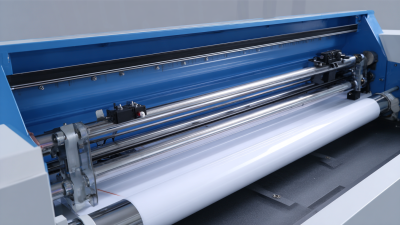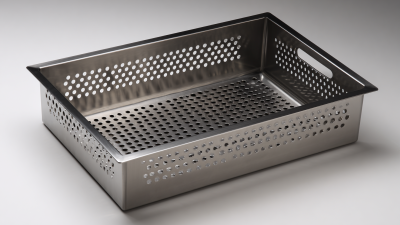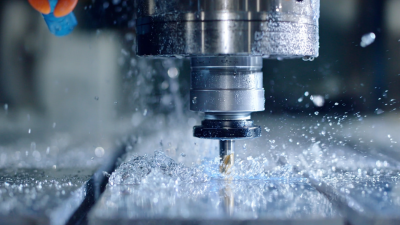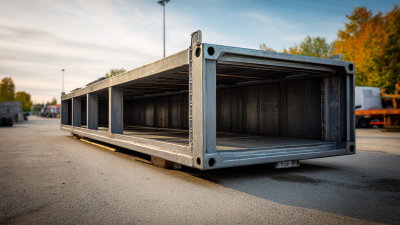The Future of Vacuum Forming Machine Technology: Innovations Transforming Manufacturing
In the rapidly evolving world of manufacturing, innovations in technology continually reshape production processes and enhance efficiency. One area witnessing notable advancements is the vacuum forming machine, a powerful tool that has revolutionized how manufacturers create complex shapes and designs from thermoplastic materials. As we explore the future of vacuum forming machine technology, it's crucial to understand the digital transformations driving these changes. This blog will delve into the reasons why advancements in automation, connectivity, and material science are essential in optimizing vacuum forming machines, ultimately leading to greater precision, reduced waste, and improved production timelines. By embracing these innovations, manufacturers can stay competitive while meeting the ever-increasing demand for customized and sustainable solutions in a dynamic marketplace.

Innovative Materials Driving Vacuum Forming Machine Advancements
 The vacuum forming machine technology is experiencing a significant transformation, largely driven by innovative materials that enhance efficiency and versatility in manufacturing processes. According to a report by Smithers Pira, the global vacuum forming market is expected to grow by 4.6% annually, driven by advancements in materials that increase performance and sustainability. Emerging materials such as bio-based plastics and high-temperature polymers are increasingly being utilized, allowing manufacturers to create more complex shapes and improve product durability.
The vacuum forming machine technology is experiencing a significant transformation, largely driven by innovative materials that enhance efficiency and versatility in manufacturing processes. According to a report by Smithers Pira, the global vacuum forming market is expected to grow by 4.6% annually, driven by advancements in materials that increase performance and sustainability. Emerging materials such as bio-based plastics and high-temperature polymers are increasingly being utilized, allowing manufacturers to create more complex shapes and improve product durability.
Tips for manufacturers looking to adopt new vacuum forming technologies include embracing lightweight composite materials that can significantly reduce energy consumption during production. Additionally, incorporating recyclable or biodegradable materials can not only align with sustainability goals but also meet the rising consumer demand for eco-friendly products.
With the shift towards automation in vacuum forming, companies should consider investing in smart machinery that integrates easily with new material technologies. Industry research from Mordor Intelligence suggests that this integration can result in up to a 30% increase in output efficiency. As manufacturers adapt to these innovative materials and technologies, a more sustainable and efficient future in vacuum forming is on the horizon.
Integration of Automation and Robotics in Vacuum Forming
The integration of automation and robotics in vacuum forming technology is revolutionizing the manufacturing landscape. Traditional vacuum forming processes have long relied on manual labor, making them time-consuming and prone to human error. However, with the advent of advanced robotics, manufacturers can now achieve greater precision and efficiency. Automated systems can handle material loading, alignment, and part removal with remarkable speed, reducing cycle times and increasing overall productivity.
Furthermore, the incorporation of smart sensors and AI algorithms enhances the vacuum forming process by allowing for real-time monitoring and adjustments. These technologies enable manufacturers to optimize material usage and minimize waste, contributing to more sustainable production practices. Robots equipped with machine learning capabilities can also adapt to variations in material properties, ensuring consistent quality in the final products. As automation continues to evolve, the synergy between robotics and vacuum forming will play a crucial role in driving innovation and competitiveness in the manufacturing sector.

Sustainability Trends: Eco-Friendly Solutions in Vacuum Forming
The drive towards sustainability is reshaping various industries, and vacuum forming technology is no exception. As the global plastic vacuum forming market is projected to reach USD 4.79 billion in 2023 and grow at a CAGR of 6.15% until 2030, innovative eco-friendly solutions are becoming pivotal to this expansion. Manufacturers are increasingly focusing on materials that minimize environmental impact, with a notable shift towards bio-based materials, which are gaining traction for their biodegradability and lower carbon footprint.
In the packaging sector, for instance, the application of sustainable bioplastics derived from renewable resources is emerging as an effective alternative to conventional plastics. This transition not only reduces environmental harm but also aligns with broader trends in the packaging industry, where sustainability remains a key driver. By leveraging such innovations, companies can not only meet regulatory challenges but also appeal to a more eco-conscious consumer base.
**Tips for Manufacturers:**
1. Consider integrating bio-based nanomaterials into your vacuum forming processes to enhance product performance while ensuring environmental integrity.
2. Stay ahead of industry trends by exploring advanced lightweight composite structures, which can reduce material consumption and increase energy efficiency.
3. Engage in continuous research on organic additives and their environmental impacts to develop more sustainable and safer product formulations.
The Future of Vacuum Forming Machine Technology: Innovations Transforming Manufacturing - Sustainability Trends: Eco-Friendly Solutions in Vacuum Forming
| Technology Innovation | Environmental Impact | Material Type | Recyclability | Energy Efficiency Rating |
|---|---|---|---|---|
| Automated Control Systems | Reduces waste materials by optimizing usage | Biodegradable Plastics | High | A+ |
| Low-Temperature Heating Elements | Lowers energy consumption | Recycled PVC | Moderate | A |
| Smart Sensors for Monitoring | Improves material usage efficiency | PLA Composites | Very High | A++ |
| Waste Minimization Techniques | Significantly reduces scrap and offcuts | Sugarcane-based Polyethylene | High | A+ |
| Energy Recovery Systems | Maximizes energy utilization | Eco-friendly PET | High | A++ |
Enhanced Precision and Efficiency in Modern Vacuum Forming Processes
In recent years, advancements in vacuum forming machine technology have significantly enhanced precision and efficiency in manufacturing processes. According to a market research report by Grand View Research, the global vacuum forming market is projected to reach USD 3.52 billion by 2025, growing at a CAGR of 5.6%. This growth is driven by the increasing demand for lightweight materials in automotive and packaging industries. Modern vacuum forming machines now utilize advanced sensors and automation technologies, allowing for tighter tolerances and improved repeatability, which is crucial for industries requiring high precision, such as electronics and medical device manufacturing.
Implementing best practices can further improve the efficiency of vacuum forming processes. Tip 1: Regular maintenance of the machinery ensures that all components function optimally, reducing downtime. Tip 2: Invest in high-quality materials designed for vacuum forming to enhance product durability and design integrity. Additionally, utilizing computer simulation software during the design phase can help identify potential issues, enabling manufacturers to make adjustments before production starts, thus saving time and resources.
With these innovations and practices, manufacturers can expect not only to increase productivity but also to enhance the quality of their products, solidifying their competitive edge in an evolving market landscape.
The Future of Vacuum Forming Machine Technology: Innovations Transforming Manufacturing
This chart illustrates the advancements in precision and efficiency in modern vacuum forming processes from 2018 to 2023. The data represents the improvements in precision (measured in microns) and efficiency (measured in production speed) over the years.
Future Outlook: Emerging Technologies Shaping Vacuum Forming Industries
The vacuum forming industry is undergoing a significant transformation as emerging technologies shape its future. According to a recent market analysis by MarketsandMarkets, the global vacuum forming market is projected to reach $3.2 billion by 2026, growing at a compound annual growth rate (CAGR) of 5.2%. This growth is fueled by advancements in materials science, automation, and precision engineering, which allow for more complex designs and faster production times.
One notable innovation is the integration of Industry 4.0 principles into vacuum forming processes. This includes the use of IoT devices and AI-driven analytics to optimize production efficiency and reduce waste. In addition, the advent of bioplastics and recyclable materials is gaining traction, significantly reducing the environmental impact of traditional vacuum forming methods. Industry leaders are now focusing on sustainable practices, which not only comply with regulatory standards but also attract eco-conscious consumers.
Related Posts
-

How to Choose the Best Vacuum Forming Machine for Your Business Needs
-

Exploring the Top Features of the Best Large Drain Pan for Global Buyers
-

Exploring the Future of CNC Machines in 2025 and Their Unmatched Advantages for Global Buyers
-

10 Essential Tips for Sourcing the Best Plastic Drip Tray for Your Business Needs
-

Transforming Efficiency in 2025 with the Best Large Drain Pan Innovation and Its Benefits
-

The Future of Sustainable Versatile Solutions with the Best Large Drip Pan in Global Markets